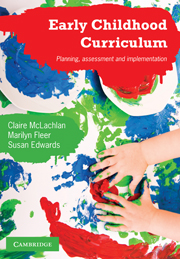Book contents
- Frontmatter
- Contents
- List of figures
- List of tables
- About the authors
- Acknowledgments
- Chapter 1 Introduction
- Chapter 2 Theory, research and the early childhood curriculum
- Chapter 3 Development and learning – how views of development shape how curriculum is framed
- Chapter 4 Curriculum as a cultural broker
- Chapter 5 Interpreting early childhood curriculum
- Chapter 6 Cultural-historical curriculum in action
- Chapter 7 Curriculum as a conceptual tool: Observation, content and programming
- Chapter 8 Assessing children and evaluating curriculum: Shifting lenses
- Chapter 9 Content knowledge: The sciences, maths and numeracy
- Chapter 10 Content knowledge: Language, literacy and ICT
- Chapter 11 Content knowledge: The arts and health, wellbeing and physical activity
- Chapter 12 Conclusions
- Index
Chapter 3 - Development and learning – how views of development shape how curriculum is framed
- Frontmatter
- Contents
- List of figures
- List of tables
- About the authors
- Acknowledgments
- Chapter 1 Introduction
- Chapter 2 Theory, research and the early childhood curriculum
- Chapter 3 Development and learning – how views of development shape how curriculum is framed
- Chapter 4 Curriculum as a cultural broker
- Chapter 5 Interpreting early childhood curriculum
- Chapter 6 Cultural-historical curriculum in action
- Chapter 7 Curriculum as a conceptual tool: Observation, content and programming
- Chapter 8 Assessing children and evaluating curriculum: Shifting lenses
- Chapter 9 Content knowledge: The sciences, maths and numeracy
- Chapter 10 Content knowledge: Language, literacy and ICT
- Chapter 11 Content knowledge: The arts and health, wellbeing and physical activity
- Chapter 12 Conclusions
- Index
Summary
In this chapter we will explore the concepts of ‘development’ and ‘learning’ in relation to curriculum development. It will be argued that how we think about these concepts shapes how we develop curriculum for the early years. Development, defined as an internal and evolving process, will be examined in relation to ‘Developmentally Appropriate Practice’ and development as a cultural-historical interaction will then be discussed in the context of changing views on early childhood curriculum.
DEVELOPMENT AND CURRICULUM
REFLECTION 3.1
What assumptions do we have about children, childhood, learning and development?
When we look at curriculum documents prepared by early childhood professionals from a range of countries we notice differences in what they value in terms of:
development and learning.
children and childhood.
These values are reflected in what they want their curriculum to do, and thus in what the outcomes for children and society will be. Three examples of curriculum statements are given below.
In the first example, Carlina Rinaldi (2006) is being interviewed about her views on curriculum in the context of the important work being done in Reggio Emilia, Italy for early childhood education:
As a reaction against people who classify us in Reggio as working with an emergent curriculum, I have been thinking about a concept that might be called a ‘contextual curriculum’. […]
Information
- Type
- Chapter
- Information
- Early Childhood CurriculumPlanning, Assessment, and Implementation, pp. 34 - 50Publisher: Cambridge University PressPrint publication year: 2010
